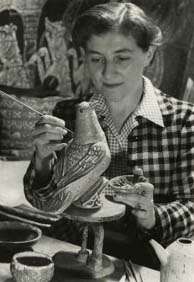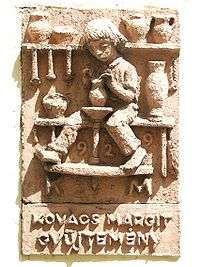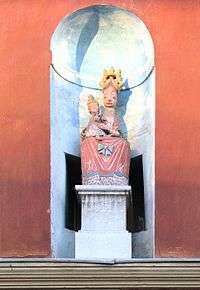Margit Kovács
Margit Kovács (1902–1977) was a Hungarian ceramist and sculptor.
Margit Kovács | |
|---|---|
 | |
| Born | November 30, 1902 Győr, Hungary |
| Died | June 4, 1977 (aged 74) Budapest, Hungary |
| Nationality | Hungarian |
| Education | State School of Applied Arts, Munich |
| Known for | Ceramics |
| Website | www |

Life

Margit Kovács was born in Győr, Hungary on 30 November 1902. She originally wished to become a graphic artist but she grew interested in ceramics in the 1920s and went to study in Vienna with Hertha Bücher, a famous Austrian ceramic artist, from 1926-1928. Then she studied clay modelling in Munich at the State School of Applied Arts under Karl Killer (1928–29). She was a fellow student here, then lifelong friend of Julia Bathory, glass artist. She studied in Copenhagen in 1932 and in 1933 she was at Sèvres Porcelain factory where she mastered the art of modelling with chamotte clay to make figures.
She won international awards in Milan, Paris, Berlin, Brussels and Rome. She was very popular in Hungary and received many public commissions. The Communist regime gave her the Distinguished Artist Award in 1959.
Kovács died in Budapest on 4 June 1977. Her grave is in Farkasréti Cemetery in Budapest.
Work
Her first public exhibition was in Budapest in 1928 and from then on her output was prolific and she continued working throughout the Second World War. She produced statuettes, pots, plates, wall plaques and tiled murals.
Her main themes are country folk, family life and bible stories. Her work is very varied but is characterised by flowing lines which curve sensually to evoke sentiment. One of her most significant works of religious art is the portal of the Saint Emeric Church (Szent Imre templom) of Győr (1939–1940).
Several of her ceramic murals are still visible in Budapest and other cities. Those in Budapest at the time of her death were:[1]
| Fisher Boy, 1932 | Ponty utca 14 |
| St. Florian, 1935 | Fürst Sándor utca 16 |
| The Peacock Alighted, c.1935 | Vármegy utca 15 |
| Signs of the Zodiac, c.1936 | Foyer of Kosciuszkó Tádé utca 14 |
| To the Old Post House, 1937 | Régiposta utca 13 |
| Budapest, Queen of the Danube, 1937 | IBUSZ, Roosevelt tér 5 (fragment) |
| Adam and Eve, c.1939-40 | Vámegy utca 15 |
| Fishing, Hunting, 1942 | Lobby of Bimbó út 11 |
| The First of May, 1946 | Ministry of Education |
| Map of Lake Balaton, 1950 | Hall of the Déli railway station |
| Fountain Pool, c.1950 | Pioneer Store (demolished) |
| Folk Dance Group Rehearsing, 1952 | Ministry of Foreign Affairs |
| The Seasons, 1953 | Budapest Museum of History |
| The Matyó Family, 1955 | Museum of Applied Arts |
| Wine Harvest, 1955 | Museum of Applied Arts |
| Games, 1959 | Ministry of Education |
| The Meteorologist, 1960 | National Meteorological Institute |
| Two Girls Went to Pick Flowers, 1961 | Museum of Applied Arts |
| In Remembrance of Things Past, 1961 | Blood Donor HQ |
| Into the Woods, 1965 | Home for Handicapped Children |
In 1972 she donated the majority of her work to the Pest County Museums Directorate in Szentendre. A museum of her work was opened in 1973 in Vastagh Street, Szentendre. There is also a collection in Győr.
References
- Pataky-Brestyánszky
- Lea Schenk, Margit Kovács Photo Album, Budapest, 2007 ISBN 978-963-00-6484-2 (2001)
- Ilona Pataky-Brestyánszky, Margit Kovács, Budapest, Corvina/Képzőművészti Kiadó, 1976 ISBN 963 13 2628 4
External links
- The Kovács museum
- Fine Art in Hungary
- International Art Portal
- Pottery, Politics and Identity: Three Hungarian Ceramicists and the Central European Diaspora
| Wikimedia Commons has media related to Margit Kovács. |
Gallery
 Old Post Office Building in a Budapest street
Old Post Office Building in a Budapest street Plaque in Vármegye street, Budapest
Plaque in Vármegye street, Budapest Ceramic panel at the Bécsi Gate of Buda Castle
Ceramic panel at the Bécsi Gate of Buda Castle